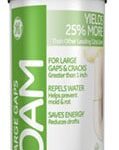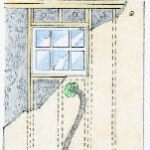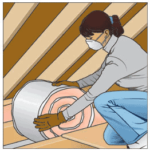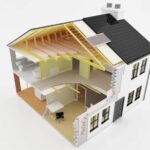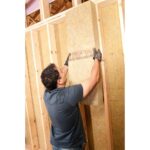One of the simplest and least expensive ways to lower your energy costs and cool your house in summer is to install a foil radiant barrier insulation in your attic.
As discussed in the Insulation Buying Guide, radiant barrier foil insulation is made of a thin sheet of aluminum or other reflective material laid over attic insulation or secured to the roof rafters. Designed to reflect the heat absorbed by a roof on hot, sunny days, radiant barrier foil keeps he attic air cooler and thereby reduces the amount of heat transferred to the living spaces below.
Foil Insulation Installation
In an existing attic, you can either staple rolls of foil radiant barrier insulation to the rafters or lay the foil out on top of the insulation. Attaching radiant barrier insulation to the rafters is the most effective method to employ, but both methods have their advantages and disadvantages.
Laying the radiant barrier on top of attic floor insulation is the easiest way to install it, but it’s more likely to get dusty that way, and the Department of Energy estimates that, as a radiant barrier accumulates dust, its efficiency can be decreased by up to 50%. It also makes navigating the attic space more dangerous, as you won’t be able to easily identify where the roof joists are located. In addition, water vapor can condense on the underside and dampen the insulation, reducing its effectiveness and encouraging mold growth. If you decide to go with an attic floor installation, make sure to purchase a radiant barrier that allows moisture to evaporate.
Attaching foil radiant barrier insulation to the underside of the roof allows for better ventilation in the attic—reducing heat buildup in the summer and removing damaging moisture in the winter—and it does not obscure the location of joists. However, it can reduce the life of asphalt shingles on your roof (since the heat is reflected out, shingles can become up to 10 degrees F. hotter than they normally would). You need more time for a roof-rafter installation than an attic floor installation since it’s harder than just laying radiant barrier over the insulation; plus, you need more materials as the area of a pitched roof is greater than that of the floor.
Proper Installation Tips
With either installation, make sure the reflective material faces upward so it directs heat away from the house. For your own comfort and safety, try to avoid installing it in the middle of the summer, when your attic is at its hottest. Also, having a helper will make a relatively simple job even easier. Take care not to cover vents or lighting, and be careful not to snag any electrical wiring.
Wear protective clothing, a dust mask, and protective gear on your head as nails sometimes poke through the roof decking. If your attic is unfinished, use a piece of plywood laid on the roof joists to distribute your weight and help you navigate; otherwise, a wrong step could send you plunging through the ceiling below.
The cost of installing a radiant barrier depends on the type of insulation you have, the type of radiant barrier you choose, and whether you hire a contractor to do it or do it yourself. When purchasing the barrier itself, make sure it’s rated Class A by the National Fire Protection Association to meet all building code regulations. You can buy radiant barrier online.



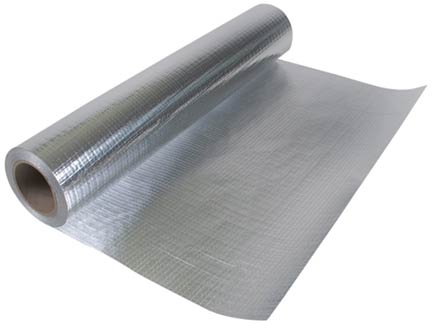




 Don Vandervort writes or edits every article at HomeTips. Don has:
Don Vandervort writes or edits every article at HomeTips. Don has:
